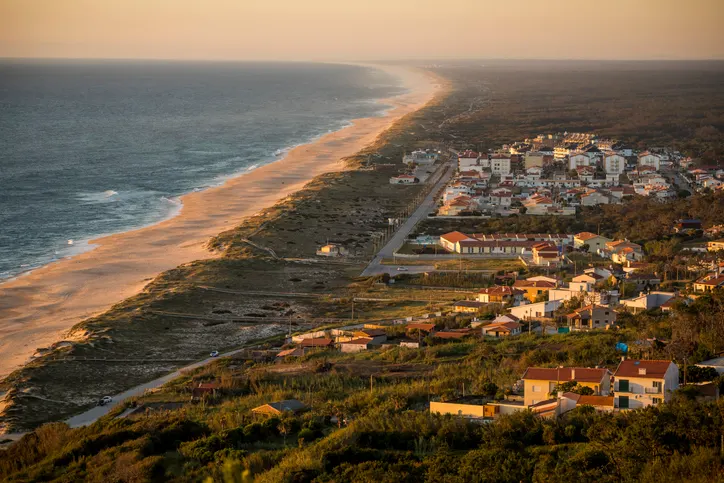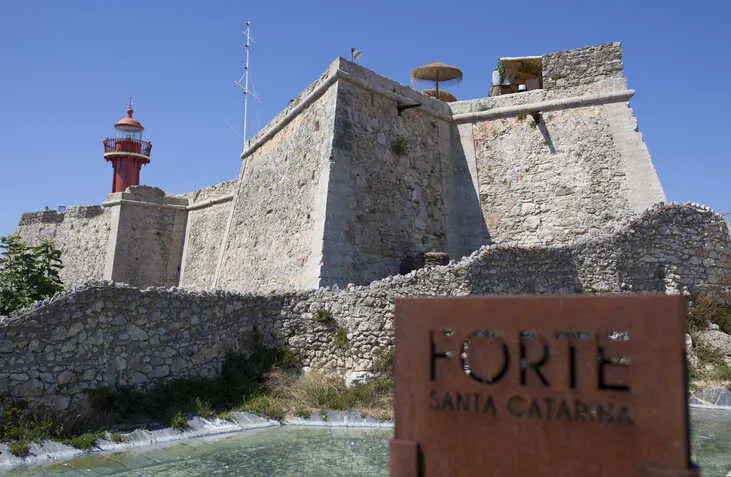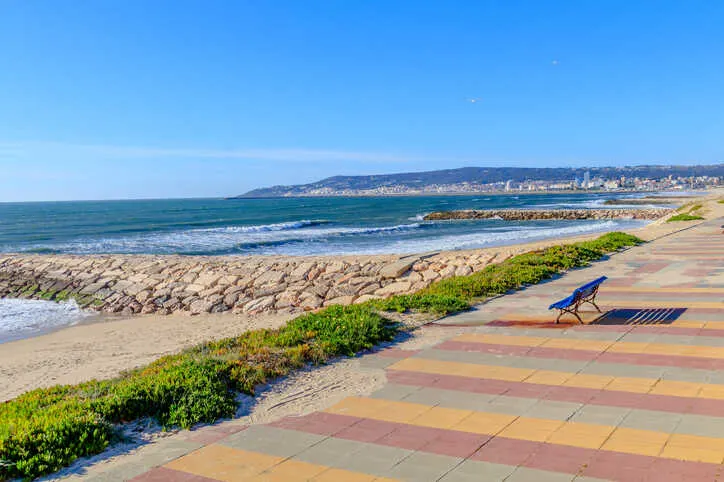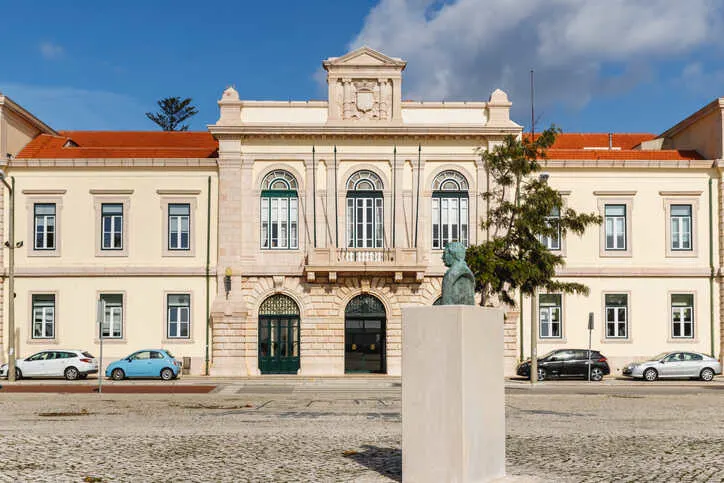On a brilliant summer day, the sun is sparkling on the expansive blue waters of the Atlantic. Gulls soar overhead, and the golden sand beach is invitingly clean. On Largo Dom Margarida Mendonça Barraca, a flea market is underway, where antique furniture, tables of retro pottery, and other memorabilia tempt passersby. Less than ten minutes away, other tables are brimming with fresh produce, fish and meats, baked goods, linens, and more at the indoor Mercado Engenheiro Silva.
Welcome to Figueira da Foz. With a population of about 65,000, this dynamic seaside community on Portugal’s Silver Coast is about the size of Birmingham, Alabama. It’s an easy two-hour drive north from Lisbon along autoestradas A17 and A8. It’s even quicker from Porto: 90 miles, an hour and a half, via A17 and A1.
Perhaps settled in Neolithic times, “Fig,” as it is fondly called, is situated where the River Mondego meets the Atlantic Ocean and is sheltered by the Serra da Boa Viagem mountains. It was a major deep-sea fishing port long before it became the bustling city it is today. This history is documented at the Sea Museum located at Rua Governador Soares Nogueira, 32 in Buarcos. The Salt Museum, 20 minutes south of the Sea Museum, offers more about the region's natural background regarding salt ponds and nature conservation.
Get Your Free Portugal Report Today!
Get Your Free Portugal Report Today!
Discover why we love a slower pace of life in Portugal and info on other European countries in our daily postcard e-letter. Simply enter your email address below and we’ll send you a FREE REPORT – Explore the Old World in Laidback Portugal.

By submitting your email address, you will receive a free subscription to IL Postcards, Overseas Dream Home, The Untourist Daily and special offers from International Living and our affiliates. You can unsubscribe at any time, and we encourage you to read more about our Privacy Policy.
Natural Beauty and Beaches

The town is the proud possessor of Portugal’s largest beach—an almost two-mile stretch of sand known as Rainha das Praias—Queen of Beaches. This expanse is divided into thirteen individual beaches. The one nearest town—literally across the road from the city center—is named Relógio after the prominently displayed town clock and is a blue flag beach. Blue flag certifications are highly prized, acknowledging excellence in areas such as cleanliness and water quality by the Foundation for Environmental Education. Relógio offers sports areas, cycle tracks, children’s parks and playgrounds, and disabled access.
Praia do Cabadelo is popular with surfers, while folks seeking a more low-key seaside experience may head north for interesting rock formations and quieter beaches like Murtinheiro or Quiaios, which lie past the forested hills of Serra da Boa Viagem.
Possibly the nicest beaches on Figueira’s long sandy stretch are in Buarcos. While many first think of Nazaré as famous for its surfing challenges and competitions, Buarcos has its own claim to fame in that community and is known for having one of the longest waves in Portugal. Named after a traditional fishing village at the northern end of the bay, about a mile from the town center, Buarcos is considered a suburb of Figueira, but its feel is quite different. Many residents still work in the fishing industry, evidenced by the number of seafood restaurants and bars on the waterfront. The town retains much of its original charm, and its beaches are an undeniably quieter alternative to Relógio.
History and Culture

In addition to its natural beauty, Figueira da Foz (“Fig Tree at the Mouth of the River”) has much to offer in terms of history and culture.
The Santa Catarina Fortress tells its stories through the centuries, from its foundation beginning in 1385. Construction began on the current structure in 1585 when Coimbra City Hall members asked Philip I of Portugal to build a fort at the entrance to the mouth of the Mondego River on the rocks known as Santa Catarina Hill. In 1602, the coast of Figueira da Foz was ravaged by British privateers, and the fort was sacked, and in 1808, it was occupied by Napoleonic troops. A few months later, two dozen volunteers from the University of Coimbra forced the surrender of the French garrison at the fort, bringing them to Coimbra to be arrested. Talk about student power! Today, the fortress, home to the Santa Catarina Lighthouse, is a perfect place to grab a drink or meal and watch the setting sun.
Much of the architecture and many original objects no longer exist, but the church of São Julião is considered one of the oldest religious structures in Portugal. Dating from around 1080, it formed the focal point of a small grouping of simple houses in a place then known as São Julião da Foz do Mondego. Reconstructed in the 16th century and remodeled during the 18th century, the church features a single nave and a side chapel with a lovely 16th-century stone altarpiece and still holds a Sunday service at its location on Rua Galamba Marques.
If archaeology is your thing, head to the Municipal Museum, founded in 1894 by Dr. António dos Santos Rocha. Located on Rua Calouste Gulbenkian, you’ll find an eclectic mix of Roman coins, medieval statues, African and Oriental ethnography, and weapons from across the ages.
On Largo Professor António Victor Guerra, 4, Casa do Paço was built in the late 17th century by Coimbra Bishop Dom João Melo as his holiday home. The main attraction are the Delft tiles depicting scenes including landscapes, knights, and Biblical themes. The mystery is, how did the tiles get there? Legend has it the treasured tiles were recovered from a Dutch shipwreck in 1706.
Palácio Sotto Maior is the sumptuous former residence of Portuguese businessman Joaquim Sotto Maior. The Neo-Renaissance building, dating from the early 19th century, is not only a museum but a venue for exhibitions, concerts, fashion shows, and more. Located at Rua Joaquim Sotto Maior, 75.
Things to Do

The casino in Figueira da Foz may not have the caché of the one in Estoril (spy central during World War II and the inspiration for Ian Fleming’s Casino Royale), but it is one of the oldest and largest casinos on the Iberian Peninsula. Modern outside and Old World elegant inside, daily shows, gaming rooms, bars, and restaurants make it a sought-after local entertainment option.
The town’s bullfight stadium, the Coliseu Figueirense, dates from 1895 and is located about a ten-minute walk from the fortress. For more than 100 years, they have not killed the bulls, who enter the ring only once, after which they may likely live on a stud farm. The venue, seating 6,000, is used not only for traditional purposes but also to host musical and other cultural events.
Of course, a huge draw is the coastline, so a beach guide will be helpful when planning your visit. If you’re into water sports, check out Riactiva in nearby Aveiro. While their focus is on windsurfing, kite surfing, kayaking, etc., including offering courses, they also have bikes for rent.
What about local events or festivals? While the annual Figueira da Foz Song Festival was discontinued long ago (1973), there are special events you can learn about by clicking here and, especially for band performances, at this site.
But you don’t have to attend a concert to experience art forms. You can just stroll around and view the street art of talented people such as Add Fuel, aka Diogo Machado, who has exhibited his work around much of the world and lives in Cascais. Or walk through the tunnel in the wall of the fortification in Buarcos and view the lovely azulejo tiles depicting what life was like in Buarcos many years ago. Speaking of which, outside of those fortress walls, take note of the wooden racks and the old photos of women using them to dry fish caught by the seafaring husbands.
For other ideas about what to see and do, take advantage of the Tourist Information Office of Figueira da Foz located on Avenida 25 de Abril, in the Castelo Engenheiro Silva in the middle of the Antonio da Silva Guimarães Esplanade, opposite the Relógio Clock Tower. While there, go upstairs to view the sculptures of Laranjeira Santos. You will also see his work in the form of the nude woman reclining in the water pool by the Santa Catarina fortress. This sculpture initially offended the local population but is now fondly referred to as A Preguiça, “The Lazy Woman.”
Get Your Free Portugal Report Today!
Get Your Free Portugal Report Today!
Discover why we love a slower pace of life in Portugal and info on other European countries in our daily postcard e-letter. Simply enter your email address below and we’ll send you a FREE REPORT – Explore the Old World in Laidback Portugal.

By submitting your email address, you will receive a free subscription to IL Postcards, Overseas Dream Home, The Untourist Daily and special offers from International Living and our affiliates. You can unsubscribe at any time, and we encourage you to read more about our Privacy Policy.
Where to Eat
The abundance of restaurants, cafés, and bars in Figueira is outstanding. Here are some of the best and most popular eateries, along with their specialties.
Ricardo and Andre at Zagallo Kitchen have elevated the selection and preparation of quality cuts of meat to an art form. If that’s what you are in the mood for, check out this excellent restaurant at Rua Académico Zagalo N21a.
Pizza lovers need to look no further than Gusto Pizza on Rua Maestro David Sousa. In addition to pizza, Alex is famous for pallo, street food made with pork that devotees rave about. He offers the specialty at a food truck stand on the beach in Buarcos in the summertime.
Lovers of Japanese cuisine will want to pay a visit to Restaurante Akaza Sushi for perfectly cooked fish, sushi, and vegetarian options. And who can resist house-made soy sauce? Rua da Cerâmica 2.
Another superb choice for fish is Caçarola Dois, at Rua Bernardo Lopes, 85-89.
Kamone Bar e Petisqueria’s menu features a lot of fried options, but before you rule it out, you should know it offers a tasty bitoque sandwich—lean steak usually topped with a crispy fried egg. The location, right on the Mondego, cannot be beat. Find it at Centro Náutico Ginásio Clube Figueirense.
The Portuguese consider leitão, suckling pig, a national treasure. O Forninho on Rua Dos Pescadores in Buarcos is a local restaurant specializing in this beloved Portuguese dish.
Want to go simple? At Praça General Freire de Andrade 18, Café Praça 18 is known for great burgers and vegan options, and Tás-cá Dentro Gastro Club at Rua dos Pescadores, 84A, serves an immense prata do dia, a multi-course lunch option at a fixed price.
Cap it off with a sundae from Gelataria São Marco in Buarcos. Your taste buds will thank you.
Getting Around

How to get around in Figueira da Foz depends on your taste, needs, and pocketbook. Keep it simple with the public transit or call an Uber or taxi service. Rent a bike from the above-referenced Riactiva or Biclaria Bike Rental and Tours, also in Aveiro (45 minutes from Figueira), whose website indicates they will deliver.
It’s also possible to rent a car. If you do, and would like to venture away from Fig for the day, you might head to Montemor-o-Velho. The castle, arguably the oldest in Portugal, is well maintained and, since 2014, has hosted the Festival Forte each August, featuring electronic music and visual and performing arts. In town, treat yourself to a queijada, a local pastry made of cheese, eggs, milk, and powdered sugar.
Where to Stay
There are almost 200 listings on Booking.com for lodging in Figueira da Foz, so with proper planning and a reservation, you should easily find a suitable place to stay during your visit. Three excellent choices here range from a bed and breakfast to a five-star hotel.
Bacharéis Charming House is located in the heart of Figueira, a five-minute walk to the Municipal Museum and Municipal Market. The lovingly restored 1878 home has nine rooms and offers homemade breakfast.
Universal Boutique Hotel is one of the favorite places we have ever stayed in Portugal. Contemporary and steeped in history at the same time, we found the service at this four-star hotel located in the Barrio Novo (“New Block”) professional yet personal. Close to the casino and beach. (Note: The Bairro Novo dates from the 1860s and, inspired by some French resorts, faces the sea. It was the city’s response to the increasing number of summer visitors coming to Figueira. Some of the loveliest turn-of-the-century houses, many with Art Nouveau and Art Deco elements, were built here.)
If you really want to splurge, consider the five-star Malibu Foz, where you can dine at the acclaimed Italian restaurant Mensa, relax in the El Septimo Premium Cigar Lounge, and enjoy the use of the spa, fitness center, and outdoor swimming pool.
Budgeting For Your Trip
Expect to spend about $200 a day for two people. Here’s a sample breakdown: $7 for breakfast per person at your hotel, or less for a morning snack at a local café. Lunch at a mid-range restaurant costs about $12 per person, and dinner costs $20 with wine. Adjust your estimates accordingly if you decide to pick up groceries and dine in your room on some days or splurge on dinner at a fancy eatery.
Accommodation ranges from hostels at around $70 to mid-range hotels at $110 to luxury rooms at $185 per night.
Add on entrance fees, transportation, beach rentals, etc., and you reach that $200 figure.
Get Your Free Portugal Report Today!
Get Your Free Portugal Report Today!
Discover why we love a slower pace of life in Portugal and info on other European countries in our daily postcard e-letter. Simply enter your email address below and we’ll send you a FREE REPORT – Explore the Old World in Laidback Portugal.

By submitting your email address, you will receive a free subscription to IL Postcards, Overseas Dream Home, The Untourist Daily and special offers from International Living and our affiliates. You can unsubscribe at any time, and we encourage you to read more about our Privacy Policy.
